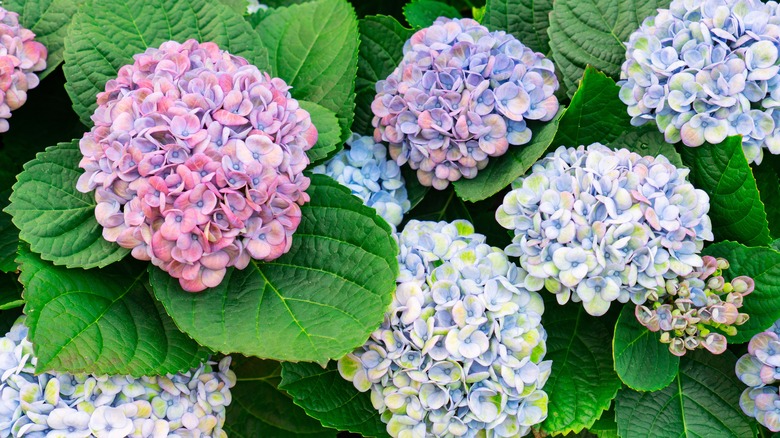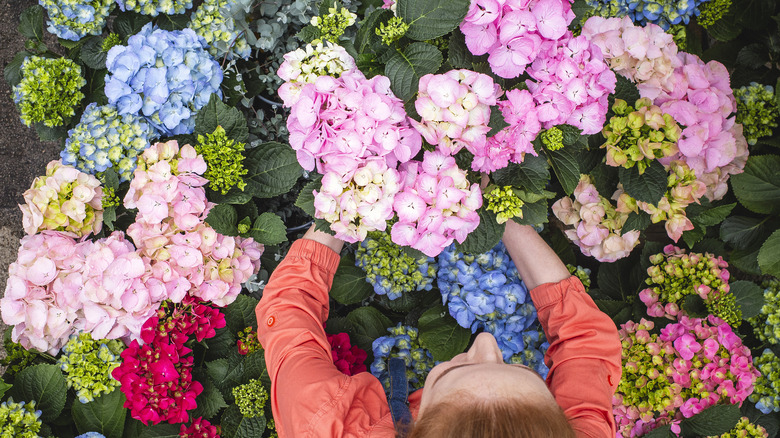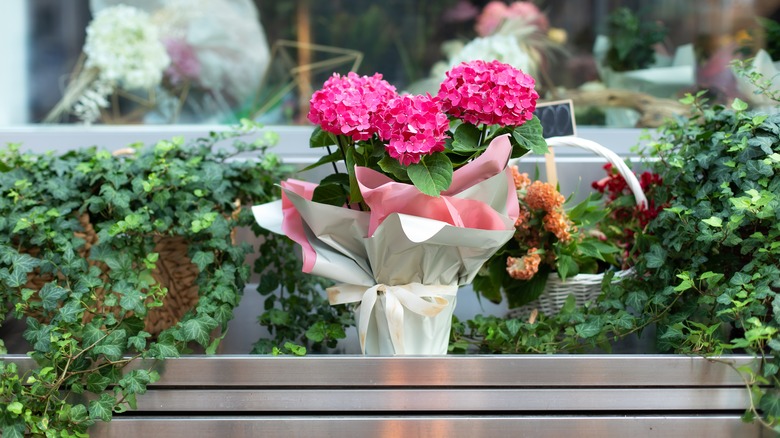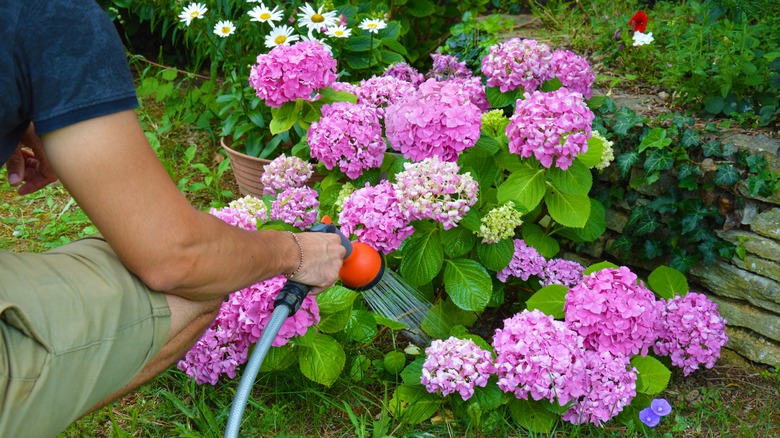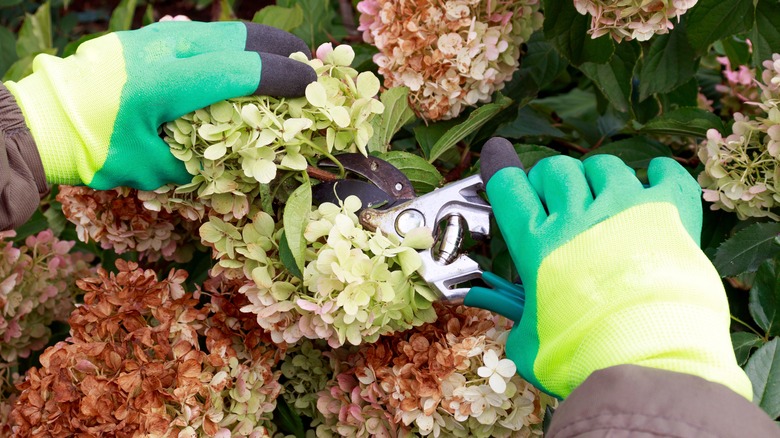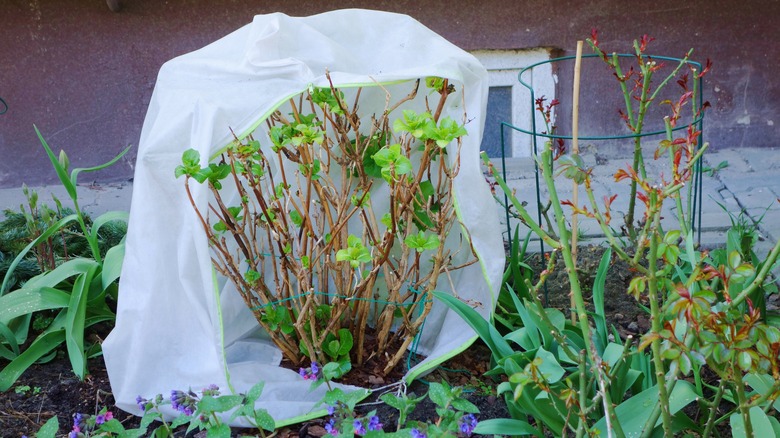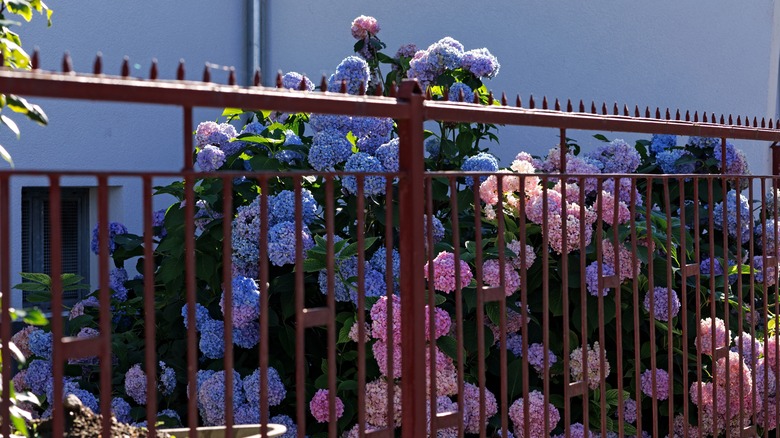Gardening Tips And Tricks For Successful Hydrangea Blooms Every Year
Hydrangeas are one of the most popular ornamental shrubs, and for good reason. Their showy blooms make stunning additions to several types of gardens. So, whether you want to plant a well-organized formal garden or design the perfect cottage garden, hydrangeas can help you achieve it — especially when following helpful tips and tricks.
Depending on the variety, the eye-catching shrubs can grow up to a whopping 15 feet tall, while climbing varieties can climb to heights of 50 feet. Native to the Americas and Asia, hydrangeas have various meanings and symbolisms from different cultures. In Japan, hydrangeas represent understanding and apology, while in Europe, these flowers are associated with boastfulness. The colors convey differing meanings as well. Pink symbolizes deep emotions like romance, blue is synonymous with apologies, white represents vanity, and purple is a way to show appreciation or embody royalty.
If you want to enjoy successful hydrangea blooms every year, you'll have to meet a few requirements to keep them healthy. However, the extra effort is worth the reward. Keeping the tips and tricks below in mind will result in large flower clusters filling your garden with a sweet scent. Plus, hydrangeas go dormant in the winter before popping back up when temperatures rise, so, with the proper care and implementation of the following suggestions, you'll be able to enjoy these elegant flowers for years to come.
Choose the right variety for your garden
With over 70 varieties to choose from, you can no doubt find a hydrangea that will thrive in your backyard, while also matching your aesthetic. Generally speaking, hydrangeas prefer a location that receives partial shade or filtered sun. Most like shade in the hot afternoons, but some varieties like more sun than others. When it comes to creating your perfect floral display, you'll find several types of hydrangeas, including both vining and shrub varieties. For example, climbing hydrangeas (Hydrangea anomala) are plants perfect for using a trellis, while panicle hydrangeas (Hydrangea paniculata) are deciduous shrubs that make beautiful borders or foundation plants.
Your best bet for achieving showy hydrangea blooms will be to carefully choose varieties that will thrive in your backyard conditions. However, what better way to enjoy hydrangea flowers than choosing a plant that blooms throughout the season? Despite the failed attempts of many gardeners who overfeed or relentlessly deadhead their hydrangeas to try to get them to produce more flowers, standard varieties will not re-bloom in the same season. Although there isn't any magic trick you can perform to get second blooms, there are several varieties that bloom off both old and new wood. Some examples of re-blooming plants include forever and ever, everlasting, and endless summer hydrangeas.
Avoid planting gift-wrapped hydrangeas
As you're entering the grocery store with a strict list in mind, you find yourself suddenly entranced by the stunning hydrangea display. Nearly every gardener has been there before, and some may even think about taking off the gift wrap and planting it directly in the backyard. However, if you're given a Mother's Day hydrangea or scooped up a few yourself, these plants are best kept indoors. Even when given the best love and care, they typically don't have a high chance of reblooming, especially when thrown into a garden. More often than not, the flowers you see on the holiday gift tables have been overfertilized and forced into early blooms. Plus, these pretty flowers may not even be hardy in your region.
If you simply can't leave the store without a hydrangea (we get it), it's best to leave the gift aisle and head to the gardening section. It's advisable to make your choice during the growing season, ideally when the flowers are in bloom. This way, you'll know exactly what you're getting and can choose whichever shade or variety best suits your garden. Before you fall in love with a certain plant, look at the roots to make sure they're healthy and white. Brown roots indicate plant health issues, and you'll be in for more work than you bargained for with no guarantee it'll recover. Generally, the best time to plant your new hydrangeas is in late spring, long after the season's final frost.
Give hydrangeas proper nutrition
One of the best ways to encourage hydrangea blooms is to ensure your plants are receiving optimal nutrition. Although they aren't too picky about soil, they prefer organically rich and well-drained blends. For many types of hydrangeas, the pH of the soil is the key to getting the shades you want. Alkaline soil (pH above 7) will encourage pink flowers, acidic soil (pH below 6) will produce blue flowers, and neutral to acidic soil may result in purple or a mixture of pink and blue. However, some varieties have set colors no matter what the pH is.
When it comes to fertilizing hydrangeas, it's crucial to know which variety you have in order to choose the optimal food for growth. Like with the soil acidity, certain fertilizers can change the color of your blooms. Organic fertilizers are more eco-friendly, while inorganic hydrangea food tends to be less expensive, but more potent, giving you bigger flowers. Reading fertilizer labels can be tricky, but phosphorus is the main ingredient you'll want to focus on. Plant food high in phosphorus tends to boost hydrangea blooms, while nitrogen will primarily enhance leaf and stem growth. However, for best results, choose a fertilizer that matches the needs of your particular variety. Remember, feeding too much or too often doesn't increase blooms, and instead may damage the plant. Test your soil before applying any fertilizer to help you determine which nutrients are lacking, and don't feed your hydrangeas if the soil is already nutrient-rich.
Water your hydrangeas properly
Hydrangeas require lots of water and prefer evenly moist, well-drained soil. If you live in a region that doesn't get consistent rainfall or has periods of drought, you'll probably need to water your plants even more often. The best method for watering hydrangeas is to water deep enough to wet the roots, but not so much that you waterlog them. Knowing how often to water your hydrangeas is only half the battle; you'll also need to make sure you water at the right time of day and in the right spot.
If you've ever held a magnifying glass underneath the sun, you know how quickly the sunlight can burn what you're aiming at. However, instead of a magnifying glass, water droplets can harness the sun, causing burns on the foliage. With this in mind, you don't want to risk getting water on the leaves or blooms during peak heat hours. Instead, aim for early morning, so you can hydrate the roots to prepare them for a sunny day without risking damage. Avoid overhead watering as this can lead to fungus diseases like crown rot. Hold the hose or watering can as close to the soil as you can, minimizing the droplets landing on the flowers or foliage. Luckily, there have been many hydrangea advancements, and there are plenty of newer varieties that better combat fungal diseases. Even if you opt for hydrangeas with fungal-resisting benefits, your best bet is to water them properly to reduce the risk.
Prune at the right time
Knowing how to prune hydrangeas is a must-know skill to encourage new growth for the next season. Hydrangeas either bloom from new wood, meaning they grow from fresh growth, or old wood, meaning they grow from what they put out the previous year. If you're unsure what variety you have, you can tell the difference by looking at the stems. Old wood looks gray or brownish, which causes newbie hydrangea gardeners sometimes to think their plant is dead. Thankfully, it's not the case; this just means they need pruning at a different time of the year. That said, if you cut them at the wrong time, you risk having no blooms the next year. New wood tends to retain its greenish tinge and is more flexible than previous growth.
You should prune old wood hydrangeas, such as the bigleaf hydrangea (Hydrangea macrophylla) immediately after they bloom. This allows the plant to work on growth that will become old wood for the next season. New wood varieties, like panicle hydrangeas (Hydrangea paniculata), develop buds on the current season's growth and need pruning in late winter or early spring. Don't worry, removing a lot of stems at once won't affect next season's blooms; the shrub will bounce back beautifully when the temperatures rise again. It's important to note that there are a few varieties that are the exception to the rule, so knowing the type of hydrangea you have is the key to proper pruning.
Protect hydrangea's delicate buds from frost
Just because hydrangeas lie dormant over winter doesn't mean they don't need protecting. If your hydrangea plant isn't blooming, it could be because their delicate buds died off during a cold winter night. To prepare your hydrangeas for winter, shelter them about a month before you expect the first frost to hit. Cover your plants with a breathable material like burlap or frost cloth during freezing weather. Remove the fabric when temperatures rise above freezing to allow your plant to receive fresh air and sunlight.
Another method is to create an insulation cage using stakes and chicken wire. Then, carefully fill the area with pine needles or leaves to help keep your plant insulated and warm. Adding a thick layer of mulch around the base of your hydrangeas can also add some extra protection. Just make sure to remove the mulch before spring; otherwise, the lack of airflow could damage the roots.
One common mistake gardeners make when they're new to growing hydrangeas is not watering during the off-season. Hydrangeas need plenty of moisture year-round, so don't skimp on watering just because your plants aren't in bloom. Give them a good shower every few days in the fall to make sure your roots remain healthy and strong for the cold months ahead. In the winter, you'll likely only need to water them about once a month.
Keep your plants protected from hungry deer
It's hard not to love the big, billowy blooms hydrangeas have to offer. Unfortunately, we aren't the only ones who enjoy them — deer love munching on the buds. Keeping deer out of your yard isn't the easiest feat, but it's not impossible. Creating a barrier is the best way to keep unwanted wildlife out, so consider installing fencing around your plants. Another option to deter these hungry animals is to add deer-repelling plants to your garden. Catmint, for example, is a great companion plant for hydrangeas and isn't loved by deer. This is a great low-cost option for those who don't have the budget to add a fence to their garden.
If you don't have a protective barrier, you'll want to pull out all the stops to keep out unwanted four-legged intruders. Deer deterrent spray is a great way to stop deer in their tracks and make them run the other way. Apply it every evening as spring emerges to teach deer that this isn't a place for them to get their food. Once they catch on that your yard is off-putting, they're more likely to find a new location to find their meals. You can also add a motion-detecting sprinkler system near your plants. The sudden blast of water will scare them away from your plants and out of your garden.
